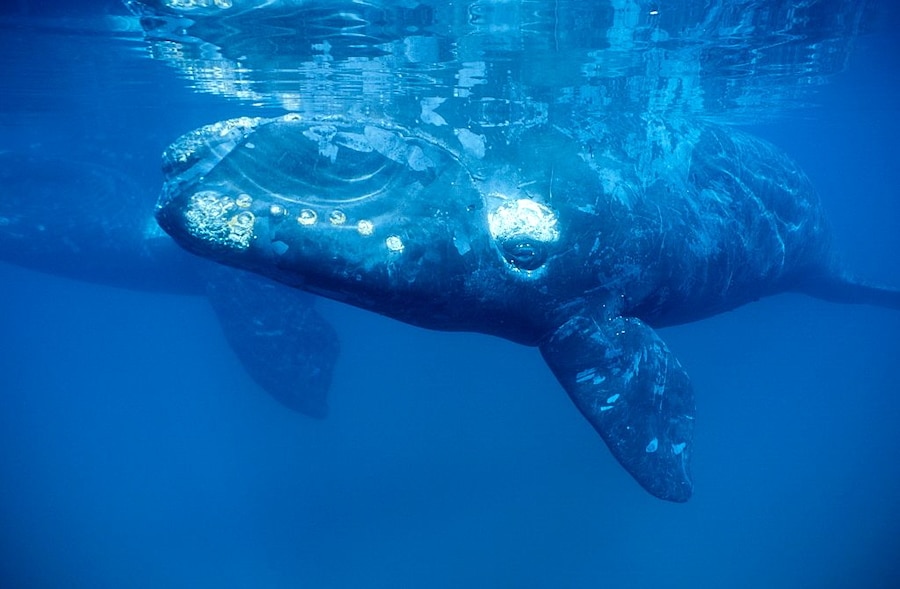This post was originally published on Eco Watch
Scientists have estimated that bowhead whales — the longest-living whale species — can live more than 200 years.
It was once thought that the bowhead’s cousin, the right whale, had an average lifespan of about 70 to 80 years, but new research has revised that estimate to more than 130 years — nearly twice as long!
“From the standpoint of physiological scaling, these superannuated ages should not be unexpected. Whales are the largest living animals, and body size is highly correlated with longevity,” the authors of the study wrote.
The researchers worked with Indigenous subsistence hunters from Utqiaġvik, Alaska. They used chemical analysis of bowhead whales that had been killed to demonstrate that they are able to live more than two centuries, a press release from University of Alaska Fairbanks said.
The chemical evidence was corroborated by harpoon tips from the 19th century being recovered from bowheads killed during modern hunts.
Right whales are more closely related to bowheads than any other species and appear to have similar lifespans. Like their cousins, right whales filter their food through baleen plates and make seasonal migrations to birthing grounds.
The names given to right whales were sadly from whalers considering them to be the “right” whales for hunting because their thick blubber caused them to float after they had been killed.
“Industrial whaling, which for most species ended only 60 years ago, would have required any individuals now aged over 100 years to have survived at least 40 years of intense whaling, and any individual over 150 would have had to survive 90 years of that same intense hunt,” the authors wrote in the study. “Given that many whale species were reduced to less than 10% of their original population size, and the population minima for most species were reached in the mid-20th century, that degree of whaling would have rendered superannuated individuals extremely rare or completely absent from the age structures of most populations. Consequently, extremely old whales may not be part of the demographic makeup of current whale populations, even if they historically existed.”
The researchers looked at four decades of data that had been collected through photo identification programs tracking critically endangered North Atlantic right whales — who live along North America’s Atlantic coast — and Southern right whales, found south of the equator, the press release said.
The research team constructed survivorship curves — graphs showing how many of a population survives to each age — using the data, which are similar to those insurance companies use in the calculation of human life expectancies.
Their analysis showed that Southern right whales can live longer than 130 years — with some possibly living to 150 years — rather than the 70 to 80 years that had been previously thought.
In contrast, the team found that the average North Atlantic right whale lifespan is only 22 years, with few individuals living past 50.
Associate professor Greg Breed with University of Alaska Fairbanks explained that the stark contrast between the lifespans of bowhead and right whales is mostly due to human impacts.
“North Atlantic whales have unusually short lifespans compared to other whales, but this isn’t because of intrinsic differences in biology, and they should live much longer,” Breed, who is lead author of the study, said in the press release. “They’re frequently tangled in fishing gear or struck by ships, and they suffer from starvation, potentially linked to environmental changes we don’t fully understand.”

A North Atlantic right whale swims off with a small amount of fishing rope after a disentanglement effort. Florida Fish and Wildlife Conservation Commission, taken under NOAA research permit #15488
Breed has been studying marine mammals for years, including seals. Certain seal species have lifespans of up to 50 years. Narwhals can live a century or more.
Breed noted that there have been significant underestimations of whale lifespans in the past due to lack of whale aging data.
“We didn’t know how to age baleen whales until 1955, which was the very end of industrial whaling,” Breed explained. “By the time we figured it out, there weren’t many old whales left to study. So we just assumed they didn’t live that long.”
The new research could provide valuable information for future conservation efforts.
“To attain healthy populations that include old animals, recovery might take hundreds of years,” Breed said. “For animals that live to be 100 or 150 and only give birth to a surviving calf every 10 years or so, slow recovery is to be expected.”
The study highlights the essential nature of cultural knowledge in whale communities.
“There’s a growing recognition that recovery isn’t just about biomass or the number of individuals. It’s about the knowledge these animals pass along to the next generation,” Breed said. “That knowledge isn’t just genetic — it’s cultural and behavioral. Older individuals teach survival skills. Younger animals learn by observing and copying the strategies of the older ones.”
Breed and his colleagues plan to expand their research to additional whale populations and explore the possibility of other whale species currently believed to have lifespans of roughly 80 years living much longer. The researchers hope to discover more about whaling’s impact on the number of long-lived individuals in current populations and predict when they will recover to pre-whaling population numbers.
The study, “Extreme longevity may be the rule not the exception in Balaenid whales,” was published in the journal Science Advances.
The post Right Whales Can Live 130 Years or Longer, Research Finds appeared first on EcoWatch.





0 Comments